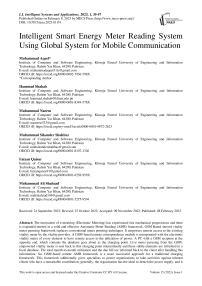Intelligent Smart Energy Meter Reading System Using Global System for Mobile Communication
Автор: Muhammad Aqeel, Hammad Shahab, Muhammad Naeem, Muhammad Sikander Shahbaz, Faizan Qaisar, Muhammad Ali Shahzad
Журнал: International Journal of Intelligent Systems and Applications @ijisa
Статья в выпуске: 1 vol.15, 2023 года.
Бесплатный доступ
The innovation of e-metering (Electronic Metering) has experienced fast mechanical progressions and there is expanded interest in a solid and effective Automatic Meter Reading (AMR) framework. GSM Based shrewd vitality meter perusing framework replaces conventional meter perusing techniques. It empowers remote access to the existing vitality meter by the vitality provider. A GSM-based remote correspondence module is incorporated with the electronic vitality meter of every element to have remote access to the utilization of power. A PC with a GSM recipient at the opposite end, which contains the database goes about as the charging point. Live meter perusing from the GSM-empowered vitality meter is sent back to this charging point intermittently and these subtle elements are refreshed in a focal database. The total month-to-month utilization and the due bill are informed back to the client after handling this information. So, GSM-based remote AMR framework is a more successful approach for a traditional charging framework. This framework additionally gives specialists to power organizations to take activities against tolerant clients who have a remarkable contribution; generally, the organization has the ideal to detach the power supply, and it can reconnect the control supply after the affidavit of duty. So, we thought about building such an automatic system. This research is GSM-Based on a smart energy meter reading system to eliminate the conventional way of the reading system. In this paper, the GSM module sends reading information through SMS to the related Authority. There are no chances of any unethical mistake by using this modern technique.
GSM, Smart Energy Meter, Smart Meter Reading, Applications, IoT
Короткий адрес: https://sciup.org/15018984
IDR: 15018984 | DOI: 10.5815/ijisa.2023.01.04
Текст научной статьи Intelligent Smart Energy Meter Reading System Using Global System for Mobile Communication
GSM is Based on Smart Energy Meter Reading System (SEMRS) which can replace a Simple Electrical energy meter; there are many different types of energy meters (coil sensor, digital, analogue, impulse, etc.), Here we use an impulse meter that generates an impulse that is the consumption of 0.01 unit and after completing 100 impulses it trips to 1 unit recorded it for furthermore process [1]. With the latest technology, the GSM module and the way the meter itself will send the energy meter unit. The main purpose of this research is to monitor the digital energy meter; the department can check the status of the meter and can get rear readings going to that place, which helps to overcome the waste of money in visiting cases [2]. Many times, billing occurs due to improper unit reading and reading mistakes by the reader, and the consumer receives the wrong bill and identifies the applicable funding agency here [3]. If none, delete this process creates a problem for the department and state, while this research is eliminating these problems and making a safe meter reading system that is beneficial for consumers as well as for the department and state. Arduino module will collect unit information from the energy meter and show it on LCD and send this information to the o department by GSM module [4]. The conventional way of meter reading systems that is adapted from the invention of electricity has many problems. When an electricity provider company provides electricity to their customer then their employee goes on long distance at the house of the customer or consumer makes a connection by his name by allotting an energy meter and after a month or a specified time interval company send a reader for taking a reading of that meter, so that company sends a bill of consumed electricity units [5]. During all this practice there are many mistakes that is possible would be a common mane and a little bit of mistake in the form of over-reading (write units more than consume units) or under reading (write units less than consume units) both mistakes are bad and unethical for department and customer. All the upper described problems are possible to eliminate, but now these are the following problems according to a conventional system. 1) Loss of time, 2) Poor reading system, 3) Unethical mistakes, 4) Lack of knowledge, 5) Irresponsible reader, 6) Improper Billing, and 7) Loss of energy. Here just a few problems are discussed which occur nowadays. The first is “Loss of Time”, when a reader is going to the customer place where the meter is located for reading, so a lot of time is required for collecting consumed units. The second is a “Poor reading system”. After going to the required area, location, or destination time readers are not able to take reading properly and note some reading with missing some number; that’s the reason for mistakes in the billing system. The third is “Unethical mistake”, sometimes when readers are going for reading and take the reading at that time, they do mistake by itself in return of some money that is offered by the customer, and they easily do changes without fear of their supervisor and top management because they are not with them [6]. This brings many changes in system efficiency and causes load shading and many problems that are faced by the department. Fourth is “Lack of knowledge”, in reading lack of knowledge is the main problem in reading, while reading in two phases is easier than in three phases [7]. When we rake reading readings of three-phase, we must calculate some values and add previous values and subtract them from previous record values; after this process we received consumed units of this meter which is more difficult than a simple two-phase and single-phase energy meter reading system. Fifth is “Irresponsible reader”, Being a responsible reader, they can perform their duties according to the requirements but whenever the employee shows irresponsibility or less interest in their work so they cannot perform their duties, that is harmful to the department because they will be the cause of department failure. Sixth is “Improper Billing” When reader will not perform their duties to collect correct data then it is 100 percent sure that the billing of that customer will be improper which shows favouritism and blaming department and state also [8]. This type of mistake is very dangerous for departments and states because when any national asset is not producing a good revenue it forces for taking borrow for making the budget for the national other departments to run successfully to save the state and these are blame departments, state, and current government also [9]. Here the question of any state development is arising that is showing any country interest in development, that other global countries are not willing to work with and invest in that country; this shows how a little mistake destroys a country's reputation [9]. The last one is “Loss of energy”, which is the factor that is, depending on the upper all factors, loss of energy reduces or decreases the efficiency of a system. The system which is not efficient is dangerous for the department to survive more on their revenue-making ratio; this is the main factor in Pakistan. To make innovation in Pakistan is our means of concern to work on this research [10]. According to the problem statement here, we declared our Aims and objectives and plan to achieve to while working on this research. The objectives of our research are. Work efficiency time efficiency, resolving reader mistakes, saving HR cost, controlling corruption, exact billing, save energy, and eliminate conventional way. The first is “work efficiency and time efficiency”. We already discussed that work and time efficiency is very important for departments and the state. According to this research work efficiency and time efficiency is 99.99 percent because whenever the department is required unit information, it will send a command to the meter and then the meter responds by sending unit information back by the GSM module [11]. When any system works time-efficiently, it plays an effective role in state development, and other countries also take interest in that research then, which shows the strength of the state [12]. The second one is “resolving reader mistakes” by this way we can resolve the mistakes of our employee (reader) by checking him in that area where we plant out GSM-based SEMRS, so we will take the reading manually and compare it with the direct reading and checkout mistake and point where the problem is occurring, which very helpful for a department to check the loyalty of an employee. The third is “Saving HR cost”, innovating this new technology can save department HR costs that consume maximum in taking the readings of the meter in the different areas. The fourth one is “controlling corruption”, in this research there are no chances of corruption because when the department directly takes unit information, and no individual is participating in the whole process in this way corruption is automatically controlled and receiver received correct bill information [13]. Fifth is “Exact Billing”, this research sends exact bill because once the department takes direct unit-consumed information then it will send a proper bill according to the consumed unit, not over and under billing. Sixth is “Save Energy”, basically a loss of energy that occurs when anyone uses energy without pay. But here, taking correct reading and exact billing, there is no chance of loss of energy; so, after using it company saves a lot of energy that making the department a successful and good revenue creator for the state and its strength [14]. The last one is “Eliminate the conventional way”, after introducing new technology and innovation we eliminate the conventional way of meter reading and billing, conventionally; there are many problems that affect departments and the state. GSM-based Smart Energy Meter Reading System (SEMRS) is an innovation in energy meter reading systems that has many good aspects and has a high scope with implementation in any field where we provide any type of energy are electricity, water, and gas [15]. In Daily life routine, all these given things that we use to calculate consumption we are faced many problems but with this research, smart Energy Meter Reading System (SEMRS), reduce the maximum problem and provide the facility to take accountability for daily receiving and sending amount by the calculation.
2. Related Works
In the paper design and implementation of web services based GPRS automatic meter reading System, is to enhance the administration level of the meter perusing of energy ventures, web administrations based GPRS programed meter perusing framework is advanced [16]. In this paper, the attributes of GPRS innovation and Web Services innovation are examined, and the engineering of web administrations-based GPRS programed meter perusing framework is composed. The literature portrayed the qualities of GPRS innovation and Web Services innovation and acquainted how to fabricate the web services-based GPRS automatic meter reading system with these advancements [17]. This framework has such merits as constant, wide scope, open, and simple to upkeep and expansion. At the exhibit, this GPRS automatic meter reading system has great application in down-to-earth work and ended up being right.
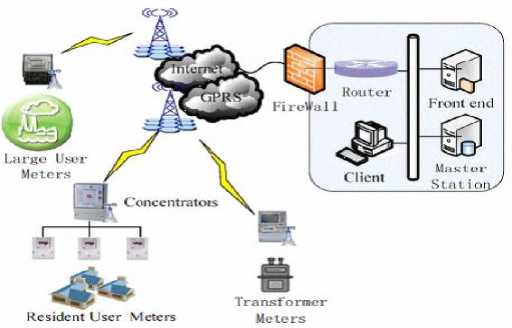
Fig.1. System Architecture.
In another paper, which is relative to the design of an automatic meter reading system, a microchip-based programed meter perusing framework is executed, which gives a practical, solid, and obstruction-free information exchange between remote meter perusing units and the utility control focus [18]. The meter perusing and administration forms are free from human inclusion. Considering the current phone systems, it is exceptionally adaptable for service organizations to access, benefit and keep up this meter perusing framework. An easy-to-understand and window-based UI is planned which completely uses the PC’s end and remains occupant programming procedure to accomplish interchanges between the remote meter perusing units and the PCs in the utility control focus [19]. The literature review depicts the equipment outline of the remote perusing unit and the product usage of the correspondence module and UI. The AMR framework comprises RRU and CFE as appeared in “Fig. 2” System Architecture interaction. The RRU is a smart end-client premises gadget that always screens and gathers utility utilization data. Reports to the Communication
Front End (CFE) through the phone arrangement, either as indicated by a foreordained timetable or on request. The CFE gathers data sent from the RRUs, and afterward amasses and transmits it to the utility host for managerial handling and charging [20].
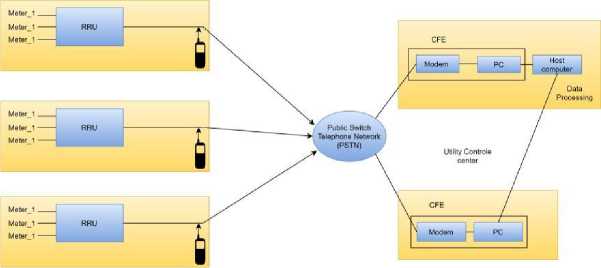
Fig.2. System Architecture Interaction.
The paper concludes on the note that an Automatic Meter Reading (AMR) framework is created, which comprises Remote Reading Units (RRU) and the Communication Front End (CFE). The capacities of the AMR framework are depicted. The capacities and highlights of the AMR framework can truly be upgraded to incorporate Home Automation (HA), Alarm/status screen, and circle support for phone organizations and remote electric load dispersion/ control. The potential chance of the AMR framework is by all accounts splendid. All over model construction and design, we do a review of different research papers regarding that area. GSM-based automatic energy meter is a new concept in which we study about GSM-based automatic energy meter that explains about modern technology use in the energy meter and later on for instant billing that is very helpful in today era because this is very busy and people like to move very fast [21]. Here new technology is introduced to overcome the time consuming and make this system very efficient, that is not in work and time. According to its operation, the meter sends unit information to the department destination, and this replaces the previous and conventional way of billing that was costly and less beneficial to more lessees. But this invention eliminates all the negative aspects and losses in energy calculation. The innovation of e-metering (Electronic Metering) has experienced quick mechanical headways and there is expanded interest for a solid and effective Automatic Meter Reading (AMR) framework [22]. The proposed framework replaces customary meter perusing strategies. It empowers remote access to the existing vitality meter by the vitality supplier. A GSM-based remote correspondence module is incorporated with the electronic vitality meter of every element to have remote access over the utilization of power. A PC with a GSM beneficiary at the opposite end, which contains the database goes about as the charging point. Live meter perusing from the GSM-empowered vitality meter is sent back to this charging point intermittently and these subtle elements are refreshed in a focal database [23]. Authentically, Clients can get to the created website page points of interest from any place on the planet. The total month-to-month utilization and the due bill are informed back to the client in the wake of handling this information. So GSM-based remote AMR framework is a more successful approach for the tradition of charging frameworks [24]. This framework likewise gives expert-to power organizations to take activities against tolerant clients who have an exceptional levy; generally, the organization has appropriate to disengage the power supply, and it can reconnect the control supply after the affidavit of duty. So thought to construct such a programed framework. So thought to build such an automatic system [25]. Literature review & analyses of the wireless energy meter is another concept of smart energy meter that helps to improve the energy calculation system to reduce the conventional problems in the conventional way of energy calculation. According to it introduces the interference of manpower that is important in this advanced era, which is going faster concerning technology and modernism that’s play an important role in the development of a state [26]. The existing traditional method for retrieving the energy meter data and billing is not convenient and time-consuming; hence this paper we suggest a billing strategy via radio frequency which is convenient and reduces the manpower. This system is a boon for remote monitoring and automatic tariff updating. This system gives information regarding meter reading, power cut, the total load used, and tempering on request or regularly in particular intervals through radio frequency. This information is being sent and received by concerned energy. Provider Company with the help of Global System. Hence this system not only reduces the labor cost and increases meter reading accuracy and saves both time and money.
3. Methods 3.1. Overview
The research methodology explains the working flow of our using the proposed model. The overview of our research is given as follows. “Fig. 3” shows the working flow of the purpose model.
-
• Arduino UNO board and IDE
-
• Proteus 8 Professional
-
• GSM module
-
• Energy meter
-
• Laptop
-
• LCD
-
• Mobile phone
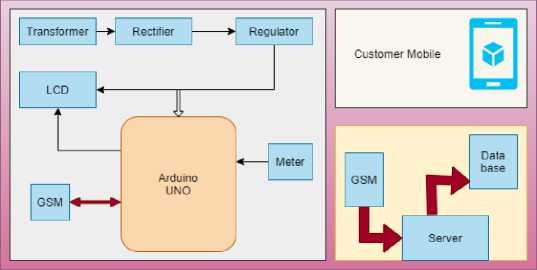
-
3.2. Meter Terminal
Fig.3. Purposed Model.
There is three main sub-model in the purpose diagram are given Meter terminal, User /Customer mobile, and Company / Server. This paper is only concerned with the meter terminal as our research name is suggested a GSMbased smart energy meter reading system. The other two units are used according to their requirement. These units are already used by the company and the user or customer. They are just linked working devices to enhance capability and to make a safe and secure system.
Meter terminals consist of five parts in which each part is very important in its performance and functionality. If any part of this terminal is inactive then the overall system is in the die position .so this terminal consists of the following components and parts shown in “Fig. 4”.
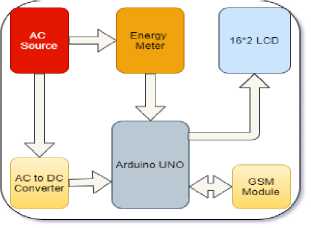
Fig.4. Meter Terminal.
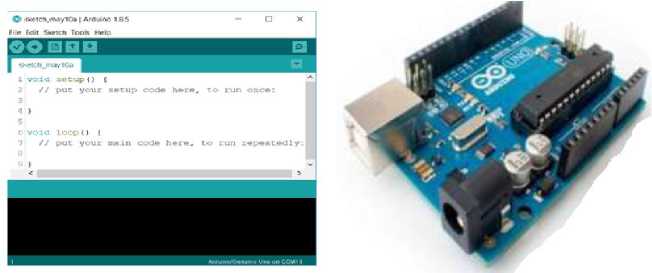
Fig.5. Arduino UNO Software Comport Code Environment and Hardware Board.
-
3.3. Arduino UNO
If it is considered the meter terminal like a human body, then Arduino UNO is the brain of this body because everything is controlled by this one individual part of this system. It is a hardware as well as a software-based open- source platform. In hardware, there is a circuit board in which we can program according to our requirements on the software side there is an Arduino IDE (integrated development environment) through which code for any purpose can be uploaded into the Arduino hardware board.it is a fully functional and integrated board and software as shown in “Fig. 5”.
In this paper, we are using the Arduino UNO board because it fulfills our all requirements and needs. It is a full packet for this research.it consists of a power USB which is used for the dual purpose to power up the Arduino and upload the computer program. It also has a separate power-up port. It has a regulator and crystal oscillator of 16 MHz which is used to calculate time.it has a reset button. It has a total 28 no of pins that are specifically designed. Pin with its description is categorized as analog and digital pins. There is 14 no of pins that declare the digital pins out of which 6 pins can be used as PWM pins. There are 5+1 analog and analog reference pins with GND and 3.3v and 5v pins. There is a reset pin and 2 pins for serially transmitting and receiving data with a specified board rate. Atml328p/168p/48p microcontroller can be used for programming the Arduino UNO board. In this paper, we use the Atml328p microcontroller which has 32kb of programmable memory and 1kb or 1024b flash memory for data storage. All pins, peripherals, components, buttons, microcontroller, power pin, and USB port are shown in “Fig. 6”.
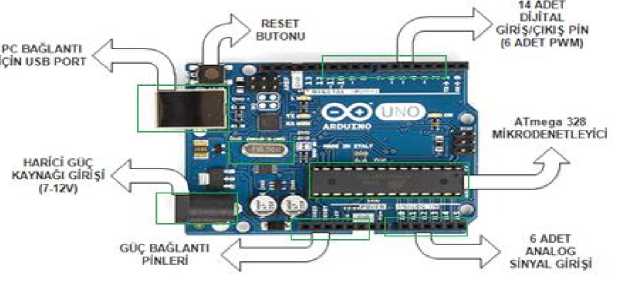
Fig.6. Arduino UNO Components and Different Ports.
These pins are easily connected to any component like LCD, Sensor, cables, etc. It TTL a compatible board so there is no separate TTL compatible circuit required like max232 IC that’s the way it is a compact circuit. Arduino UNO is the most popular open-source software we need an external editor and compiler as it provides all required resources. All kinds of libraries can be downloaded from their respective websites. First of all, we have to download Arduino IDE and then install it on the computer or laptop moreover we should know, how it is operated and can be used. After installation, it is the first step to run the software as an administrator clicks on the file button and clicks on new then a new window will open this is the programming environment for editing the source code of any kind of program. “Fig. 7” shows the full view of the software editor.
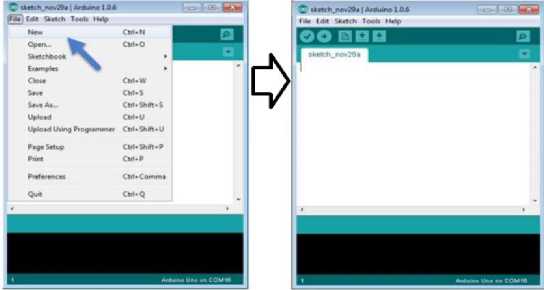
Fig.7. Arduino Compiler and Editor.
“Fig. 8” shows the Arduino IDE toolbar in which different symbols are used to declare their work in the editor. After editing mark sign is used to compile the program very next arrow is used to upload the program to the hardware with the use of a printer USB wire. The third sign shows an editor can be opened by just clicking on it. If the existing program is needed to open, then the up arrow key can be pressed and to save any open program in the directory down arrow can be used and the last one is the serial monitor. It is used to send and receive data to the Arduino UNO from the PC. Due to the serial monitor terminal, it is highly efficient we can check the data to be operated other than any monitoring device.

Fig.8. Arduino IDE Toolbar.
-
3.4. Power Supply
As we declare the research is like the human body so to remain alive it must have sole and blood there for power supply is used for this purpose. There are two types of power sources Alternate Current (AC) and Direct Current (DC). The difference between both is shown in “Fig. 9”.
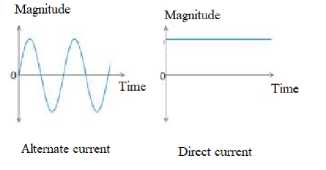
Fig.9. Waves of AC and DC.
The first one is AC on which all the heavy loads are operated like Motors, Pumps, and heavy-duty Machines in the industries. This AC is produced by using many resources like a wind turbine, dams, nuclear radiation, coal, etc. As mentioned, it is for heavy loads, so it is more beneficial because all the mechanical machinery is operated on it after petroleum, diesel, and steam. Where Ac has enough application, but it has some drawbacks which are that it cannot be stored and produced at the sport according to the requirement and another problem is that small and complex circuits are not operated it can burn these due to high rate of switching. The second one is the DC source. All the small components and circuits are operated with that source some over it can be stored for a long time in the batters. This power in this research is used because Arduino UNO operates with 5v DC. DC can on produced from the AC, from the light of the Sun by photo voltaic effect, and other different means. In this research we use AC and change it into DC for this purpose following method is used as shown in “Fig. 10”. In which the first transformer output is given to the rectifier block and its output given to the regulator which delivers pure DC voltage.

Fig.10. AC to DC Conversion Diagram.
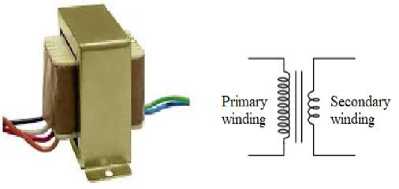
Fig.11. Step-down Transformer.
There is a step-down transformer is used to decrease the voltage from 220v to 20v AC. A step-down transformer is as shown in “Fig. 11”. This transformer is made up of two coils of wire which are winding around a chunk of iron. To decrease the voltage level of either side of the transformer only depends upon the number of turns. If the number of turns is the same on both sides, then there is no change in the voltage level. For a step up or down the primary and secondary coils should have an unequal no of turns. So, for the step-down transformer secondary coil should have less no of turns as compared to the primary coil.

Fig.12. Half-wave Rectification.
In which an AC is given for rectification to the circuit and as output circuit returns half-wave rectifier voltage but it is not over there because this type of output is not desired. This type of voltage can burn our circuit by putting the capacitor parallel to the secondary coil then the resultant output will be like as shown in “Fig. 13”.

Fig.13. Half-wave Rectification with Capacitor Filter.
Now at this stage, the half-wave rectifier plus capacitor filter removes jerks and provide some sorted output but it has maximum no of repels. This wave is enough needed to clear it for this purpose full-wave rectification process is needed. A Bridge rectifier circuit is used to remove repels and jerks.

Fig.14. Full-wave Rectification with Capacitor Filter.
Every electronic device nowadays needs a DC supply for smooth working single-phase AC supply provides this supply, so the regulator is used to convert an AC supply into constant DC. This type of power supply is also known as a linear power supply.it receives AC input and changes it into constant DC. There is the following no of ways to regulate this supply the basic solution for this purpose is to use a transistor, variable integrated circuits regulators, the Zener diode used frequently for constant regulation, and most widely 78XX and 79XX integrated circuits are used all these components provides and delivers content DC supply which is beneficial to all the electronic devices.
-
3.5. LCD
-
3.6. Energy Meter
-
3.7. GSM Module
For communication purposes, GSM is widely used all over the world. It works on different frequencies like119500MHz, 24000MHz, 9600MHz, 1800MHz, and 900MHz. it is a dual-band GSM that can send and receive data in the form of audio and characters.it is operated by using AT commands as a means of attention. Sim 900 Module is used in this research, Arduino instructs it, a destination address, and unit information. This module is working on a sim card and proceeds the process to deliver the unit information, GSM Module with its peripherals is shown in “Fig. 17”.
Liquid crystal display (LCD) is an electronic device used to display a character on the screen. It has a wide variety of but basic purpose to show information on it. In our paper, we are using 16x2 LCD just to display some information according to the requirement. We preferred LCD other than seven segments because a single seven-segment displays a single charter. It occupies more place and displays small information. In this LCD there are 16 charter displays in one row and 16 charter in 2ND row that’s why it is called 16x2 LCD. It has two registers commonly known as command and data registers. The command register is used to instruct the LED which includes blinking the cursor, setting the cursor position left or right side of the display, clearing the screen, moving the charter left to right or right to left, etc. on the other hand data register is used to store the data that to be displayed on the screen all the data in the ASCII format. Pins configuration of LED includes data pins starting from DB0 to DB7, Vcc, and ground pins for powering up the LCD. Vcc pin is used to control brightness. For instruction purposes, RS enables R/W pins to be used. LCD is interfaced with Arduino. Here is the following code as shown in “Fig. 15,” which is we used for this specific purpose first of all we include the liquid crystal library in the editor and then use the LCD parameterize function and pass the pin no in the required field first two fields for enabling E and RS pins those are used for commands instruction to LCD and the next four pins are passed into the LCD function field for data send to LCD so pin no 2,3,4,5 are used as data pins and pin 11, 12 for instructions.

Fig.15. LCD Interfacing Code
Energy meters are used to calculate the energy that is used by the customer and many types of meters are now used for calculation, Digital Meter, Analog Meter, coil Sensor, and impulse response Meter are some types. In our paper, we use an impulse response meter that generates impulse when a customer uses 0.01 units it sends impulse from the circuit board to the destination where the action is taken in the research this impulse response goes in the Arduino module and performs further action according to the units. As collecting consumed energy units is our basic research approach so in the simulation stage, we are using a push button in place of an energy meter that generates a pulse.it is connected with Arduino pin no 8 as the input pin. In the simulation, we use a push button to generate pals which show in “Fig. 16,”, and a meter interface with Arduino is given.

Fig.16. Meter Interfacing Code.
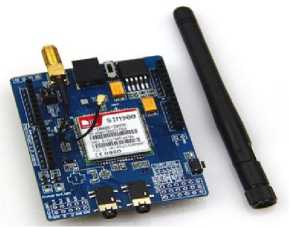
Fig.17. GSM Module Sim 900.
We add the libraries of the GSM module in the proteus, so it worked successfully. These results are seen by using a virtual terminal as shown in “Fig. 18”.

Fig.18. GSM Module Interfacing.
4. Results and Discussion
Overall results of the simulation on the proteus are shown in “Fig. 19” which shows that all the interfacing is done, and the results are according to the requirement of simulation on the proteus state. In the results, we must find our means values according to the research SEMRS that is explained through its working. The microcontroller, an LCD, GSM modem, USB-to-serial port cable for compatibility purposes, and microchip are used for constructing the GSM energy meter. This meter is designed using embedded code and AT commands which control our GSM modem for sending messages to every client’s mobile number when the administrator takes a meter reading after every month. At the time of sending the message every time, this data is stored in the non-volatile memory (EEPROM). In the office, this GSM unit will receive these collected data and local software will process that data and calculate the total energy consumption of a specific meter.
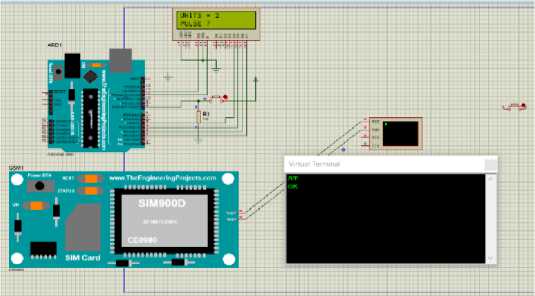
Fig.19. Simulation of Model on Proteus.
LCD interfacing code: A 16x2 LCD means it can display 16 characters per line and there are 2 such lines. In this LCD each character is displayed in a 5x7 pixel matrix. This LCD has two registers, namely, Command and Data. A 16x2 LCD is a very basic module and is very commonly used in various devices and circuits. These modules are preferred over seven segments and other multi-segment LEDs. The command register stores the command instructions given to the LCD. A command is an instruction given to an LCD to do a predefined task like initializing it, clearing its screen, setting the cursor position, controlling the display, etc. The data register stores the data to be displayed on the LCD. The data is the ASCII value of the character to be displayed on the LCD. Proteus software is used for simulation. LCD and Arduino are interfaced and burning it shows that the code working properly. The result of this simulation is shown in “Fig. 19”.
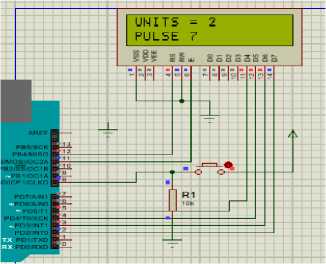
Fig.20. LCD interfacing on Proteus.
“Fig. 20” shows the interfacing is done and the results are according to the requirement of simulation on the proteus sate. In the results, we must find our means values according to the research SEMRS that is explained through its working. The microcontroller, an LCD, GSM modem, USB-to-serial port cable for compatibility purposes, and microchip are used for constructing the GSM energy meter. This meter is designed using embedded code and AT commands which control our GSM modem for sending messages to every client’s mobile number when the administrator takes a meter reading after every month. At the time of sending the message every time, this data is stored in the non-volatile memory (EEPROM). In the office, this GSM unit will receive these collected data and local software will process that data and calculate the total energy consumption of a specific meter.
MAY 16 AT 8 17 AM
Hello from GSM Modem! your current units are =

your current pulse are = 5
16 AT 5:00 PM
Hello from GSM Modem! your current units are =

your current pulse are = 5
Q В
SMS
Fig.21. Message Received from Model to Consumer.
This is the internal hardware circuit representation of our research that is practically showing the interfacing of the component with each other as were discuss in the methodology and the software side. Each component is also labeled with a specific name, and they are fixed according to the labeling. The final design and assembly of the proposed meter are shown in “Fig. 22” which is a handy tool and has less weight. On the top of the meter, there is a 16x2 LCD used for displaying reading. EEPROM is used to store the content. We used different capacitors, registers, potentiometers, oscillators, and wires for implementing the practical setup of the proposed system. This is the output of the result that is shown on the mobile or cell phone of the department that is providing the unit information to the authority show in “Fig. 21”.
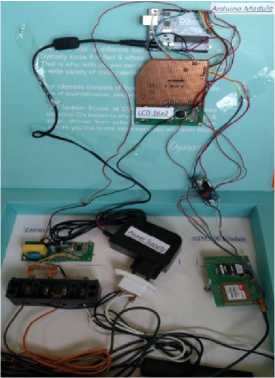
Fig.22. Hardware Interfacing.
5. Conclusions
We have concluded that the smart energy meter reading system is an invention in the field of energy meter reading systems that eliminates the conventional way of the reading system. This research is introducing new technology as well as introducing huge changes in this field that will abruptly push up to this environment to become more successful due to its a lot of positive aspects. Conventionally, we were facing a lot of problems regarding reading, billing and the complete process was depending on the different person and their loyalty to work, which is too difficult in this critical era. This paper presents a plan and examination of the results of the GSM-based smart energy meter reading system (SEMRS) on various instruments. SEMRS gives the data of meter perusing on ask for or frequently specifically interim through SMS on re-enactment based. This data is being sent and got by the concerned vitality Provider Company with the assistance of the Global framework for versatile correspondence (GSM) arrange for this reason virtual terminal demonstrates these outcomes. Vitality supplier gets the meter perusing inside a moment without going by the individual. So SEMRS is a blast for remote checking and controlling household vitality meters. SEMRS decreases the work cost, as well as increments, meter perusing exactness, and spare, embraces measure of time, yet additionally limit the number of customary visits required by utilizes of vitality Provider Company. This GSM Based Smart Energy Meter Reading System SEMRS can be upgraded in many aspects. It can be web-based control, which is a huge benefit to monitoring and controlling the status of the meter and its supply. Instant billing is also a side to which we can expand by connecting consumers via mobile phone Apps. There is also the latest idea is that we can introduce in the android App that consumer/customer can turn on or turn off his load and increase or decrease its amount of energy according to its use that will help the department to save a huge amount of energy.
Список литературы Intelligent Smart Energy Meter Reading System Using Global System for Mobile Communication
- V. K. Jaiswal, H. K. Singh, and K. Singh, “Energy Metering System,” no. Icces, pp. 448–452, 2020.
- V. Bacchad et al., “SMART ENERGY METER WITH LOAD CONTROL USING IOT,” no. 05, pp. 4878–4882, 2022.
- S. E. Met et al., “GSM based energy meter with demand response , january 2018,” no. january, 2018.
- I. Meter, “IJERT-Evolution of Smart Energy Meter Monitoring and Billing using IOT,” Academia.Edu, no. 1.
- D. Al-sehail, O. Al-Atbee, and A. Marhoon, “Smart Energy Metering Based on Arduino, GSM, and Raspberry pi3 as Server,” 2022, doi: 10.4108/eai.7-9-2021.2314803.
- M. G. Mortuza, Z. U. Ahmed, H. Jaki, M. R. Ahmed, M. J. Uddin, and M. H. Kabir, “A GSM Based Automatic Energy Meter Reading and Billing System,” Eur. J. Eng. Res. Sci., vol. 5, no. 6, pp. 725–730, 2020, doi: 10.24018/ejers.2020.5.6.1963.
- B. Ntambara and R. Umuhoza, “Design of Low Cost and Energy Efficient Smart Energy Meter of Overload Tripping with Recognition and Notification Systems based on Internet of Things,” 2021 IEEE South. Power Electron. Conf. SPEC 2021, 2021, doi: 10.1109/SPEC52827.2021.9709465.
- E. Ezeodili and K. Adebo, “Design and construction of a smart electric metering system for smart grid applications: Nigeria as a case study,” Int. J. Sci. Eng. Res., vol. 9, no. 7, pp. 798–805, 2018.
- R. Umayalakshmi, T. Server, and J. A. Jacob, “A SMART ELECTRIC METER READING AND MONITORING SYSTEM USING,” vol. 4, no. 7, pp. 39–44, 2018.
- Kannan P, A. Devaraj, Esakki Rajavel. S, Nisharni B, Sancta A, and Muthu Lakshmi M, “GSM Based Smart Energy Meter System,” vol. 0, pp. 0–4, 2021, doi: 10.3233/apc210274.
- R. Amudhevalli and T. Sivakumar, “IoT Based Smart Energy Metering System for Monitoring the Domestic Load Using PLC and SCADA,” IOP Conf. Ser. Mater. Sci. Eng., vol. 1055, no. 1, p. 012154, 2021, doi: 10.1088/1757-899x/1055/1/012154.
- J. Belwyn Samson, K. Alwin Fredrick, M. Nithin Sathiya, R. Catherine Joy, W. Joel Wesley, and S. Stanley Samuel, “Smart energy monitoring using raspberrypi,” Proc. 3rd Int. Conf. Comput. Methodol. Commun. ICCMC 2019, no. Iccmc, pp. 845–849, 2019, doi: 10.1109/ICCMC.2019.8819743.
- S. Hassan Mir, “Review on Smart Electric Metering System Based on GSM/IOT,” Asian J. Electr. Sci., vol. 8, no. 1, pp. 1–6, 2019, doi: 10.51983/ajes-2019.8.1.2340.
- M. A. Khooharo, M. Ali, I. Rana, A. A. Memon, and ..., “An An Alternate to the Problem of Complete load Shedding Using Smart Energy Meter,” Int. J. …, vol. 04, pp. 15–20, 2021.
- M. M. M. Mufassirin, “Development of Iot Based Smart Energy Meter Reading and Monitoring System,” pp. 1–9, 2018.
- A. Ahad, S. Mitra, O. Morshed, I. Khan, R. Sarker, and S. S. Chowdhury, “Implementation and Feasibility Analysis of GSM Based Smart Energy Meter for Digitalized Power Consumption with Advanced Features,” Proceeding - 2018 Int. Semin. Intell. Technol. Its Appl. ISITIA 2018, pp. 403–407, 2018, doi: 10.1109/ISITIA.2018.8711205.
- M. Tejwani*, P. M. P. Rane, M. Syed, O. Patel, and P. Pandey, “Iot Based Smart Energy Meter Monitoring and Billing System.,” Int. J. Innov. Technol. Explor. Eng., vol. 9, no. 6, pp. 1480–1483, 2020, doi: 10.35940/ijitee.f4301.049620.
- D. S. A. Joshi, S. Kolvekar, Y. R. Raj, and S. S. Singh, “IoT Based Smart Energy Meter,” Bonfring Int. J. Res. Commun. Eng., vol. 6, no. Special Issue, pp. 89–91, 2016, doi: 10.9756/bijrce.8209.
- A. Chore, P. Mali, D. Vyanjane, and ..., “IoT based smart electricity meter and billing system,” Int Res J Eng Technol …, 2018.
- Kannan P, A. Devaraj, Esakki Rajavel. S, Nisharni B, Sancta A, and Muthu Lakshmi M, “GSM Based Smart Energy Meter System,” 2021, doi: 10.3233/apc210274.
- M. Abrarul Alam and M. Zeyad, “Smart Cities and Buildings: GSM Based Smart Electric Energy Meter Billing System,” 2019 IEEE Int. Conf. Power, Electr. Electron. Ind. Appl. PEEIACON 2019, pp. 1–4, 2019, doi: 10.1109/PEEIACON48840.2019.9071923.
- M. Prathik, K. Anitha, and V. Anitha, “Smart energy meter surveillance using IoT,” Proc. Int. Conf. Power, Energy, Control Transm. Syst. ICPECTS 2018, pp. 186–189, 2018, doi: 10.1109/ICPECTS.2018.8521650.
- M. Hinchey, Jyotsna Kumar Mandal Applications of Networks , Sensors and Autonomous Systems Analytics, no. January. 2022.
- S. Hallur, R. Kulkarni, P. P. Patavardhan, and S. Santaji, “Web Based Smart Energy Metering System,” 2018 Int. Conf. Circuits Syst. Digit. Enterp. Technol. ICCSDET 2018, 2018, doi: 10.1109/ICCSDET.2018.8821099.
- N. Khan, Y. Naseer, I. Alam, T. Abbas, and Y. Iqbal, “Wireless controlled smart digital energy meter and theft control using GSM with GUI,” 2018 Int. Conf. Comput. Math. Eng. Technol. Inven. Innov. Integr. Socioecon. Dev. iCoMET 2018 - Proc., vol. 2018-Janua, pp. 1–6, 2018, doi: 10.1109/ICOMET.2018.8346430.
- N. M. Yoeseph, M. A. Safi’Ie, and F. A. Purnomo, “Smart Energy Meter based on Arduino and Internet of Things,” IOP Conf. Ser. Mater. Sci. Eng., vol. 578, no. 1, 2019, doi: 10.1088/1757-899X/578/1/012085.

